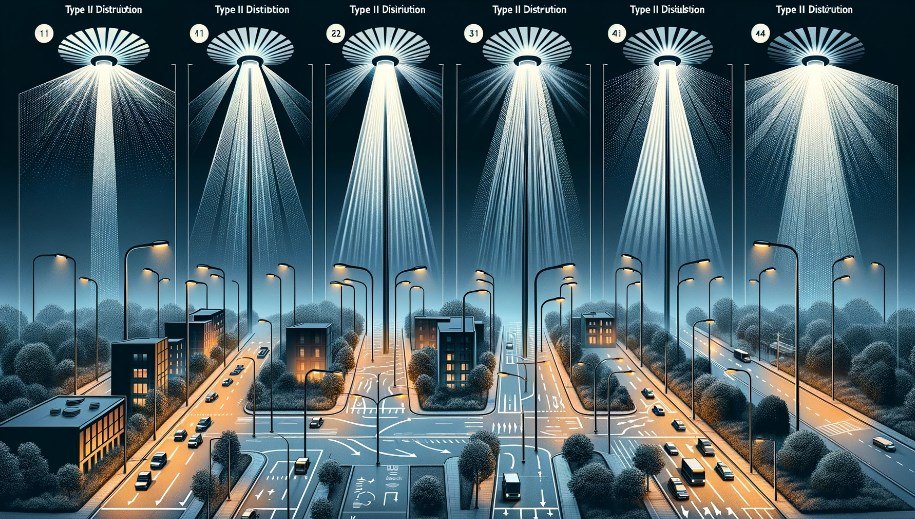The Spectrum of Solar: Understanding Different Light Distribution Types in Street LightingPosted by Stephen Shickadance in Most Popular. How Solar Lights Work.In the age of sustainable living, solar street lighting has emerged as a beacon of eco-friendly innovation. These lights not only conserve energy but also reduce carbon footprints, paving the way for a greener future. An integral aspect often overlooked, yet crucial in the efficiency of these solar lights, is the pattern of light distribution. This article delves into the different types of light distribution in street lighting and their importance in urban and rural settings.
What is light distribution pattern?Light distribution refers to the pattern in which light is dispersed from the source. In street lighting, it's not just about the intensity of light but how evenly and effectively it is spread over an area. The right distribution pattern can enhance visibility, improve safety, and even contribute to aesthetic urban design. Types of Light Distribution Patterns1. Type I DistributionType I is a lateral distribution designed for pathways, sidewalks, and narrow streets. It has a two-way lateral spread, making it ideal for locations where the width of the roadway does not exceed the mounting height of the light. 2. Type II DistributionSlightly broader than Type I, Type II distribution is suitable for wider pathways and smaller residential streets. It offers a comfortable level of brightness without encroaching into adjacent properties or causing light pollution. 3. Type III DistributionType III is designed for larger roadways, parking lots, and wider pedestrian areas. It provides a more extensive distribution of light, making it suitable for ensuring safety in more spacious public areas. 4. Type IV DistributionType IV distribution is characterized by a forward-throw light pattern, ideal for mounting on the sides of buildings and walls. This type is commonly used in parking areas and commercial premises for broader illumination. 5. Type V DistributionOffering a circular distribution, Type V is the most versatile pattern, suitable for intersections and large central areas where uniform light distribution is needed from all angles. What are the 5 components of lighting system?A lighting system typically comprises several key components that work together to provide effective illumination. The five fundamental components of most lighting systems are: Light Source: This is the most critical component of any lighting system. The light source generates the light and can vary in type, such as incandescent bulbs, fluorescent lamps, LEDs (Light Emitting Diodes), halogen lamps, or HID (High-Intensity Discharge) lamps. Each type of light source has its characteristics in terms of energy efficiency, color rendering, lifespan, and light output. Luminaire (Fixture): The luminaire, or fixture, houses the light source and is responsible for controlling and directing the light. Luminaires can also contain other components like reflectors, lenses, or diffusers to shape and distribute the light. They are designed to protect the light source and can contribute to the aesthetic design of a space. Power Supply: Lighting systems require a power supply to operate. This can be an electrical power supply system that includes wiring, connectors, and sometimes transformers, especially for low-voltage lighting systems. In the case of solar-powered lighting, this component would include solar panels and batteries. Control System: This component allows the user to control the operation of the light. Control systems can range from simple on/off switches to more complex systems like dimmers, motion sensors, timers, or smart lighting systems integrated with home automation. Advanced controls can adjust the brightness, color temperature, and even the direction of the light. Mounting System: This refers to the physical structure that supports or positions the light fixture. It can include poles, brackets, frames, or tracks, depending on the type of lighting and where it is used. The mounting system is crucial for the correct positioning of the light for optimal performance and safety. The Role of Solar Street LightsSolar street lights are increasingly adopting these distribution patterns to maximize efficiency and functionality. The combination of solar power with LED technology and intelligent light distribution caters to various lighting needs while being environmentally responsible. Advantages of Solar Street Lights with Optimal Light Distribution
Challenges and ConsiderationsWhile solar street lights with varied distribution patterns are beneficial, several challenges need addressing:
ConclusionUnderstanding the spectrum of light distribution in solar street lighting is key to harnessing its full potential. As urban areas continue to expand, and the focus on sustainable practices grows, integrating the right type of light distribution in solar street lights will play a crucial role in shaping the illuminated landscapes of our cities. With continuous advancements in technology and increasing awareness about environmental impacts, the future of street lighting looks bright, efficient, and solar-powered.
Most Popular
How Solar Lights Work
|
ArchivesNo Archives Categories
Want More Info? |
LATEST NEWS & ARTICLES

